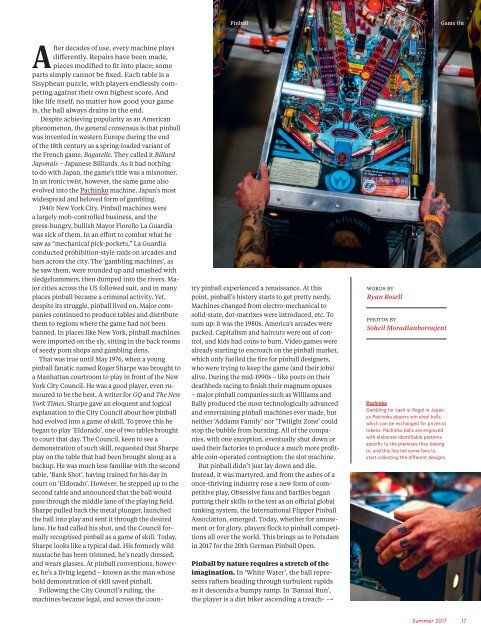LOLA Issue Four
Issue Three of LOLA Magazine. Featuring the people and stories that make Berlin special: Moderat, Microdosing LSD, Yony Leyser, Julia Bosski, Notes of Berlin, Sara Neidorf and more.
Issue Three of LOLA Magazine. Featuring the people and stories that make Berlin special: Moderat, Microdosing LSD, Yony Leyser, Julia Bosski, Notes of Berlin, Sara Neidorf and more.
You also want an ePaper? Increase the reach of your titles
YUMPU automatically turns print PDFs into web optimized ePapers that Google loves.
Pinball<br />
Game On<br />
After decades of use, every machine plays<br />
differently. Repairs have been made,<br />
pieces modified to fit into place; some<br />
parts simply cannot be fixed. Each table is a<br />
Sisyphean puzzle, with players endlessly competing<br />
against their own highest score. And<br />
like life itself, no matter how good your game<br />
is, the ball always drains in the end.<br />
Despite achieving popularity as an American<br />
phenomenon, the general consensus is that pinball<br />
was invented in western Europe during the end<br />
of the 18th century as a spring-loaded variant of<br />
the French game, Bagatelle. They called it Billard<br />
Japonais – Japanese Billiards. As it had nothing<br />
to do with Japan, the game’s title was a misnomer.<br />
In an ironic twist, however, the same game also<br />
evolved into the Pachinko machine, Japan’s most<br />
widespread and beloved form of gambling.<br />
1940: New York City. Pinball machines were<br />
a largely mob-controlled business, and the<br />
press-hungry, bullish Mayor Fiorello La Guardia<br />
was sick of them. In an effort to combat what he<br />
saw as “mechanical pick-pockets,” La Guardia<br />
conducted prohibition-style raids on arcades and<br />
bars across the city. The ‘gambling machines’, as<br />
he saw them, were rounded up and smashed with<br />
sledgehammers, then dumped into the rivers. Major<br />
cities across the US followed suit, and in many<br />
places pinball became a criminal activity. Yet,<br />
despite its struggle, pinball lived on. Major companies<br />
continued to produce tables and distribute<br />
them to regions where the game had not been<br />
banned. In places like New York, pinball machines<br />
were imported on the sly, sitting in the back rooms<br />
of seedy porn shops and gambling dens.<br />
That was true until May 1976, when a young<br />
pinball fanatic named Roger Sharpe was brought to<br />
a Manhattan courtroom to play in front of the New<br />
York City Council. He was a good player, even rumoured<br />
to be the best. A writer for GQ and The New<br />
York Times, Sharpe gave an eloquent and logical<br />
explanation to the City Council about how pinball<br />
had evolved into a game of skill. To prove this he<br />
began to play ‘Eldorado’, one of two tables brought<br />
to court that day. The Council, keen to see a<br />
demonstration of such skill, requested that Sharpe<br />
play on the table that had been brought along as a<br />
backup. He was much less familiar with the second<br />
table, ‘Bank Shot’, having trained for his day in<br />
court on ‘Eldorado’. However, he stepped up to the<br />
second table and announced that the ball would<br />
pass through the middle lane of the playing field.<br />
Sharpe pulled back the metal plunger, launched<br />
the ball into play and sent it through the desired<br />
lane. He had called his shot, and the Council formally<br />
recognised pinball as a game of skill. Today,<br />
Sharpe looks like a typical dad. His formerly wild<br />
mustache has been trimmed, he’s neatly dressed,<br />
and wears glasses. At pinball conventions, however,<br />
he’s a living legend – known as the man whose<br />
bold demonstration of skill saved pinball.<br />
Following the City Council’s ruling, the<br />
machines became legal, and across the country<br />
pinball experienced a renaissance. At this<br />
point, pinball’s history starts to get pretty nerdy.<br />
Machines changed from electro-mechanical to<br />
solid-state, dot-matrixes were introduced, etc. To<br />
sum up: it was the 1980s. America’s arcades were<br />
packed. Capitalism and haircuts were out of control,<br />
and kids had coins to burn. Video games were<br />
already starting to encroach on the pinball market,<br />
which only fuelled the fire for pinball designers,<br />
who were trying to keep the game (and their jobs)<br />
alive. During the mid-1990s – like poets on their<br />
deathbeds racing to finish their magnum opuses<br />
– major pinball companies such as Williams and<br />
Bally produced the most technologically advanced<br />
and entertaining pinball machines ever made, but<br />
neither ‘Addams Family’ nor ‘Twilight Zone’ could<br />
stop the bubble from bursting. All of the companies,<br />
with one exception, eventually shut down or<br />
used their factories to produce a much more profitable<br />
coin-operated contraption: the slot machine.<br />
But pinball didn’t just lay down and die.<br />
Instead, it was martyred, and from the ashes of a<br />
once-thriving industry rose a new form of competitive<br />
play. Obsessive fans and barflies began<br />
putting their skills to the test as an official global<br />
ranking system, the International Flipper Pinball<br />
Association, emerged. Today, whether for amusement<br />
or for glory, players flock to pinball competitions<br />
all over the world. This brings us to Potsdam<br />
in 2017 for the 20th German Pinball Open.<br />
Pinball by nature requires a stretch of the<br />
imagination. In ‘White Water’, the ball represents<br />
rafters heading through turbulent rapids<br />
as it descends a bumpy ramp. In ‘Banzai Run’,<br />
the player is a dirt biker ascending a treach-<br />
words by<br />
Ryan Rosell<br />
photos by<br />
Soheil Moradianboroujeni<br />
Pachinko<br />
Gambling for cash is illegal in Japan<br />
so Pachinko players win steel balls,<br />
which can be exchanged for prizes or<br />
tokens. Pachinko balls are engraved<br />
with elaborate identifiable patterns<br />
specific to the premises they belong<br />
to, and this has led some fans to<br />
start collecting the different designs.<br />
Summer 2017<br />
17









